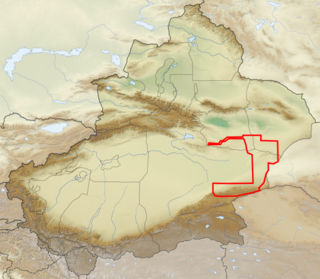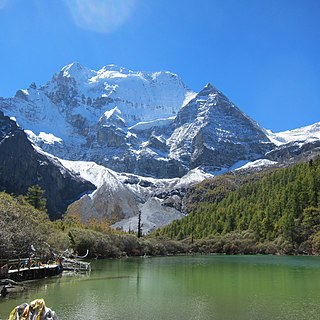 W
WAltun Shan National Nature Reserve is a large, arid area in the southeast of Xinjiang Autonomous Region, on the northern edge of the Tibetan plateau and the southern edge of the Tarim Basin in northwest China. It surrounds the Kumkol Basin, an endorheic basin in the western third of the Altyn-Tagh mountains. The reserve is sometimes referred to as the "Arjin Mountains Nature Reserve", or "Aerjinshan". The reserve covers the southern portions of Qiemo County and Ruoqiang County of Bayingolin Mongol Autonomous Prefecture in Xinjiang.
 W
WThe Baotianman National Nature Reserve is located in Nanyang, Henan, in central China. It is embedded in the much larger (909.5 km²) Baotianman UNESCO-MAB Biosphere Reserve.
 W
WBayanbulak Grassland National Nature Reserve is the second largest grassland in China, located in the Bayanbulak Basin of the Tian Shan mountains in northwest China. The terrain is mostly flat, and encompasses a middle section of the Kaidu River. The reserve is 200 km northwest of Korla in the Bayingolin Mongol Autonomous Prefecture of Xinjiang Uyghur Autonomous Region.
 W
WBolshoi Ussuriysky Island, or Heixiazi Island, is a sedimentary island at the confluence of the Ussuri and Amur rivers. It is divided between the People's Republic of China (PRC) and Russia. It has an area of about 327 to 350 km2 and is bounded closely by Yinlong Island, and over ninety islets. Its position at the confluence of the Amur and the Ussuri and right next to the major Russian city of Khabarovsk, has given it great strategic importance.
 W
WCaohai Lake is a natural water-body situated in Northwest Guizhou Province of Southwest China. The lake is situated on Weining Mountain, in the outskirts of Weining County. Caohai Village lies directly at the edge of the wetland.
 W
WChaiwopu Lake is a freshwater lake located in Dabancheng District, some 45 km southeast of Ürümqi, in Xinjiang, China. The lake receives water from several streams from the Bogda Shan range.
 W
WThe Changdao County simplified Chinese: 长岛县; traditional Chinese: 長島縣; pinyin: Chángdǎo Xiàn; lit. 'long island county') is a county in Yantai, a prefectural area of Shandong in the People's Republic of China. It consists of the Changshan Islands within the Bohai Strait, directly north of Penglai. They are known for their sandy beaches and picturesque limestone cliffs. The total land area is only 56 square kilometers (22 sq mi), but the coastline is 146 km (91 mi) long.
 W
WChangqing National Nature Reserve is located near Huayang Village in the Qin Mountains of Shaanxi province of China.Location: 300 km (190 mi) south of Xi'an Area: 300 km2 (120 sq mi) Highest point: 3,071 m (10,075 ft) Year established: 1995
 W
WThe Dafengding Nature Reserve is located in Meigu County, Liangshan Yi Autonomous Prefecture, and in the Mabian Yi Autonomous County in Leshan prefecture-level city, both in Sichuan Province in the People's Republic of China.Elevation: 1240 – 3835 meters ; 1200–4042 meters Area: 159.50 sq. kilometers ; 301.46 sq. kilometers Established: 1978
 W
WThe Dashanbao Black-necked Crane National Nature Reserve is a state-level nature reserve located in Dashanbao Township, Zhaoyang District, Zhaotong prefecture-level city, Yunnan Province, China. The reserve has been set up to protect a total area of 19,200 hectares of plateau marshland at altitudes between 2,200 and 3,300 meters that provide winter habitat for the Black-necked crane. The reserve has been designated as a Ramsar site since 2004.
 W
WFengyangshan-Baishanzu National Nature Reserve is a nature reserve in southwest Zhejiang province of eastern China. The reserve lies within Longquan and Qingyuan counties. The highest peak of Zhejiang, Huangmaojian, is located within the reserve. The present reserve was formed in 1992 by merging two provincial-level nature reserves, Fengyang Shan Nature Reserve and the Baishanzu Nature Reserve (1985).
 W
WGutianshan National Nature Reserve is a nature reserve in Kaihua County, in the western part of Zhejiang Province, on the border of Jiangxi province. The reserve was established as a smaller, provincial-level nature reserve in 1975, and upgraded to its present size and status in 2001. The reserve occupies a mountainous, forested area, and is part of the Nanling mountains. The highest peak is Shiershan at 1,258 metres (4,127 ft).
 W
WThe Honghe National Nature Reserve (HNNR), is a 218.35-square-kilometre (84.31 sq mi) Ramsar Convention-designated site in Heilongjiang Province in northeastern China. It was first established in 1984 as a provincial wetland reserve, and was upgraded to be a national nature reserve in 1996. 173 birds are known from the Reserve including protected species such as black stork, black-billed capercaillie, greater spotted eagle, the Kamchatkan or Steller's sea eagle, mandarin duck, Oriental white stork, red-crowned crane, white-naped crane, white-tailed sea eagle, and whooper swan.
 W
WHunchun National Nature Reserve is a protected area in the Changbai Mountains in northeastern China's Jilin Province. It was established in December 2001 and covers 1,087 km2 (420 sq mi) of deciduous and coniferous forests. Wildlife recorded in the reserve include Siberian tiger, Amur leopard, sika deer, roe deer, red deer and wild boar.
 W
WKanas Lake is a lake in Altay Prefecture, Xinjiang, China. The lake is located in a valley in the Altai Mountains, near the very northern tip of Xinjiang and the province's borders with Russia, Kazakhstan and Mongolia. The lake was formed around 200,000 years ago during the Quaternary period as a result of glacier movement. The crescent moon shaped lake has an estimated water storage capacity of 53.8 billion cubic meters, coupled with an average depth of around 120 meters.
 W
WLiancheng National Nature Reserve is located in Gansu Province in the Yellow River Basin. It consists of 47,930 hectares, of which 14,223 ha is core area, 13,189 ha is buffer area, and the remaining 20,517 ha is experimental area mainly targeted for the protection of the spruce ecosystem, especially Picea wilsonii.
 W
WLop Nur Wild Camel National Nature Reserve protects one of the three remaining habitats of the Wild Bactrian camel, a critically endangered species. The reserve stretches around the north, east, and south of Lop Nur, a dry lake in a desert known as the "Sea of Death", and one of the most arid regions in the world. The reserve was established in 1986 by Xinjiang Province, and has been modified over the years. The reserve is under pressure from new roads in the area, development of mining interests, and illegal hunting.
 W
WNei or Inner Lingding Island, formerly romanized as Lintin or Lin Tin Island, is an island in the Pearl River estuary in the southeastern Chinese province of Guangdong. Although it is located closer to the eastern shore of the estuary, it was until 2009 administratively part of the prefecture-level city of Zhuhai, whose main administrative center is located on the west shore of the river. The jurisdiction of Nei Lingding Island was handed over to Shenzhen in 2009.
 W
WQomolangma National Nature Preserve (QNNP), also known as Chomolungma Nature Reserve (QNP) protects 3.381 million hectares of the central Himalaya in the Tibet Autonomous Region of the People’s Republic of China. "Qomolangma" is the Tibetan name for Mount Everest. Located on the “Roof of the World,” the Qomolangma National Nature Preserve (QNNP) was one of the first nature preserves in the world to be administered and protected entirely by local volunteers. Through their continued efforts, significant achievements have been made in halting rampant deforestation, unregulated tourism and illegal hunting of rare wildlife in the Qomolangma region. Active reforestation and garbage collection programs have also been undertaken to restore the environment.
 W
WThe Sanjiangyuan, is an area of the Tibetan Plateau in Qinghai province, China which contains the headwaters of three great rivers of Asia: the Yellow, the Yangtze, and the Mekong. Parts of the area were protected as the Sanjiangyuan National Nature Reserve (SNNR), also called the Three Rivers Nature Reserve. The reserve consisted of 18 subareas, and each contained three zones which were managed with differing degrees of strictness. In 2015, the Chinese government decided to implement a new national park system, and created Sanjiangyuan National Park (SNP), which is set to open officially in 2020.
 W
WThe Taxkorgan Nature Reserve is a nature reserve in Kashgar Prefecture, Xinjiang, China. It is situated around the Taghdumbash Pamir of Pamir Mountains and Karakorum Mountains. It covers about 14,000 square kilometres (5,400 sq mi) was established in 1984 mainly to protect the rare Marco Polo sheep and Tibetan argali. It has since also served to protect other species such as the snow leopard.
 W
WTianmu Lake is a lake which is 8 kilometres (5.0 mi) south of Liyang City in Jiangsu Province, China. It was listed as a provincial tourist resort in 1993 and is currently graded an AAAA nature reserve after being graded as such in 2001. The lake covers an area of 300 square kilometres (120 sq mi), and its depth ranges from an average of 10 feet (3.0 m) to a maximum of 28 feet (8.5 m). The lake enjoys a legal conservation status, and since the municipal government took action in 1995 to overhaul the sewage disposal systems around the lake, the water quality has been in a good condition, achieving the second highest rating for water quality. As such, the lake is home to many freshwater fish such as cod.
 W
WWeizhou Island is a Chinese island in the Gulf of Tonkin. The largest island of Guangxi Zhuang Autonomous Region, Weizhou is west of Leizhou Peninsula, south of Beihai, and east of Vietnam. Administratively, it is part of Weizhou Town, Haicheng District of Beihai City.
 W
WWolong National Nature Reserve, also known as Wolong Special Administrative Region, is a protected area located in Wenchuan County, Sichuan Province, People's Republic of China. Established in 1963 with an initial size of about 20,000 hectares, the reserve was further expanded in 1975, covering an area of about 200,000 hectares in the Qionglai Mountains region. There are over 4,000 different species recorded in the reserve. According to China's Third National Giant Panda Survey, Wolong National Nature Reserve houses about 150 wild individuals of highly endangered giant pandas. The reserve is also a home to many other endangered species including: snow leopards, red pandas, golden monkeys, white-lipped deer and many precious plants. Before the devastating 2008 Wenchuan earthquake Wolong got up to 200,000 visitors every year. Its area is superseded by the Wolong Special Administrative Region.
 W
WWuyanling National Nature Reserve is a nature reserve in Taishun County, in the southern part of Zhejiang Province. The reserve occupies a mountainous, forested area. The highest peak is Baiyun Peak, which is 1,611 metres (5,285 ft) high.
 W
WNyidên (Tibetan), or Yading, is a national level reserve in Daocheng County, in the southwest of Sichuan Province, China. It is a mountain sanctuary and major Tibetan pilgrimage site comprising three peaks sanctified by the 5th Dalai Lama. The peaks are seen as emanations of the three boddhisatvas Chenrezig, Jampayang and Chanadorje, with Chenrezig being the highest peak at 6032 meters above sea level. It is served by Daocheng Yading Airport.
 W
WYushan Island is in Xiangshan County in northeast Zhejiang province, Eastern China. It is the most southeastern island in Xiangshan, located 27 miles from Shipu Town, near Ningbo City. It is situated in the north and south ocean current intersection belt, and is the line basis points of China’s territorial waters. The island's north section is the largest, with a total land area of 2.3 square kilometers.
 W
WZhalong Nature Preserve is a wetland reserve in Heilongjiang province, China.